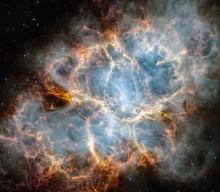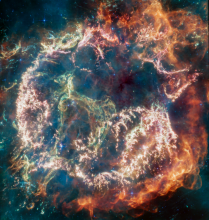Listen to today's episode of StarDate on the web the same day it airs in high-quality streaming audio without any extra ads or announcements. Choose a $8 one-month pass, or listen every day for a year for just $30.
You are here
Danger Zone
If you’re close to the right kind of supernova, it’s gonna getcha. Radiation from the initial blast can zap any planet within a few dozen light-years. Cosmic rays will hit hundreds to thousands of years later. And a recent study says the gap between those periods can be dangerous as well.
Astronomers looked at the type of supernova formed by a massive star. When the star can no longer produce energy in its core, the core collapses and the star’s outer layers are blasted into space. The blast produces radiation that can damage the atmosphere of any Earth-like planet within a few dozen light-years. Interactions with surrounding material creates cosmic rays that can do similar damage centuries later.
The new study used X-ray telescopes in space to examine 31 supernovas that were surrounded by lots of gas and dust. For decades after the explosion, the supernova blast wave heats that material, producing X-rays. The radiation could endanger Earth-like planets up to about 150 light-years away.
X-rays can destroy ozone in the planet’s upper atmosphere, allowing ultraviolet light from the planet’s own star to reach the surface. The X-rays might also create a nasty brown haze that can block the star’s light, killing plants.
Two or more nearby supernovas may have zapped Earth in the past few million years. But no likely future supernovas are close to us today — keeping our planet out of the danger zone.
Script by Damond Benningfield





